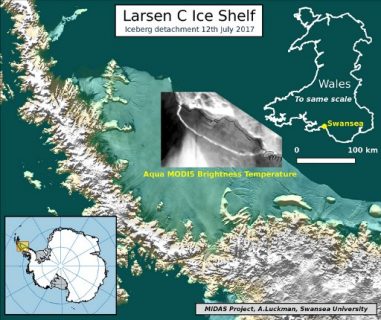
/ AFP /
by Mariëtte Le Roux
Agence France Presse
PARIS, France (AFP) — A Delaware-sized iceberg, one of the largest ever seen, was set adrift after snapping from a West Antarctic ice shelf that will be closely watched for signs of collapse, scientists said Wednesday.
A crack in the Larsen C ice shelf, a drifting extension of the land-based ice sheet, finally broke through after inching its way across the frozen formation for years.
It created an iceberg of about 5,800 square kilometers (2,200 square miles), with a volume twice that of Lake Erie, one of the North American Great Lakes.
“The iceberg weighs more than a trillion tonnes, but it was already floating before it calved away so has no immediate impact on sea level,” said a team of researchers from the MIDAS Antarctic research project.
The gargantuan ice cube will probably be named A68.
“The calving of this iceberg leaves the Larsen C ice shelf reduced in area by more than 12 percent, and the landscape of the Antarctic Peninsula changed forever,” the team added.
Separation occurred somewhere between Monday and Wednesday, and was recorded by a National Aeronautics Space Administration satellite.
The calving of ice shelves occurs naturally, though global warming is thought to have accelerated the process in some regions. Warmer ocean water erodes the underbelly of the ice shelves, while rising air temperatures weaken them from above.
Icebergs calving from Antarctica are a regular occurrence, and there are thousands of them.
The latest behemoth will be closely watched for potential risk to ships.
“The big ones are easier to spot in the ocean. This one, for sure, will be tracked very easily by satellite,” Mark Drinkwater, a European Space Agency (ESA) ice expert, told AFP.
“The concern is whether the thing breaks up into a myriad of smaller bergs.”
There is also a risk that smaller, loose pieces which stayed behind when the main chunk broke off will now calve away.
“There appears to be a number of fractures that might indicate that other pieces might break away later,” Drinkwater said.
The fate of A68 is hard to predict.
Drinkwater said it could “hang around” for some time before the tides and wind force it further out to sea.
According to an ESA statement, ocean currents could drag the iceberg, or pieces of it, as far north as the Falkland Islands, posing a hazard for ships in the Drake Passage.
Will it collapse?
Experts disagree over whether the calving heightens the risk of Larsen C disintegrating like its neighbours Larsen B in 2002 and Larsen A in 1995.
Floating on the ocean, ice shelves are fed by slow-flowing glaciers from land. Without them, the glaciers would flow directly into the sea.
If the glaciers held in check by Larsen C were to spill into the Antarctic Ocean, it would lift the global water mark by about 10 centimeters (four inches), previous research has shown.
With its new shape and size, Larsen C may be less stable, the MIDAS researchers warned.
“In the ensuing months and years, the ice shelf could either gradually regrow, or may suffer further calving events which may eventually lead to collapse,” said lead investigator Adrian Luckman.
“Our models say it will be less stable, but any future collapse remains years or decades away.”
Drinkwater, however, said satellite data and years of on-site investigation show the shelf “is in a very stable configuration.”
“We’re going to be watching very carefully for signs that the rest of the shelf is becoming unstable,” added Swansea University glaciologist Martin O’Leary, another MIDAS project member.
For Catherine Ritz of France’s CNRS research institute, the iceberg calving pointed to rising pressure from global warming.
“It is a sign that ice shelves are more and more vulnerable,” she told AFP. “These Larsen (shelves) existed already at the beginning of the Holocene” — the current geological period that began about 12,000 years ago.
But O’Leary and Drinkwater said this particular iceberg calving was unrelated to global warming.
According to O’Leary, “we’re not aware of any link to human-induced climate change,” while Drinkwater called it “a typical iceberg calving event” along a very old fault lines in the ice shelf.
This did not mean other shelves were not already feeling the effects of warming, however.
And in the future, “there is certainly with climate warming a chance of ice shelves being removed further and further south along the Antarctic peninsula,” Drinkwater said.
Human actions have lifted average global air temperatures by about one degree Celsius (1.8 degrees Fahrenheit) since pre-industrial levels, according to scientists, and Antarctica is one of the world’s fastest-warming regions.
© Agence France-Presse








